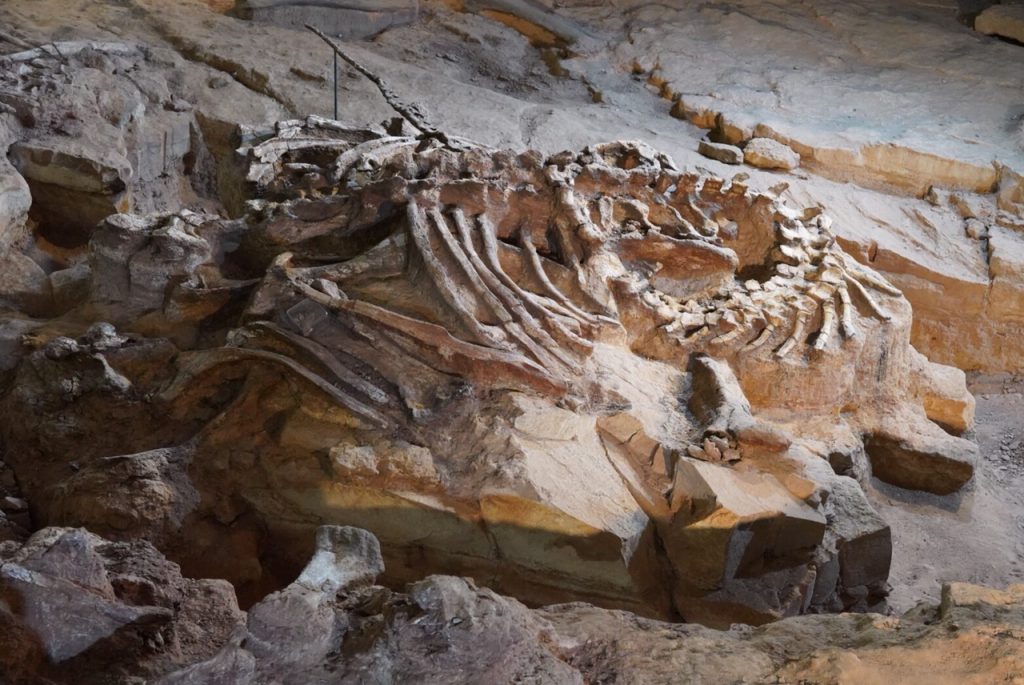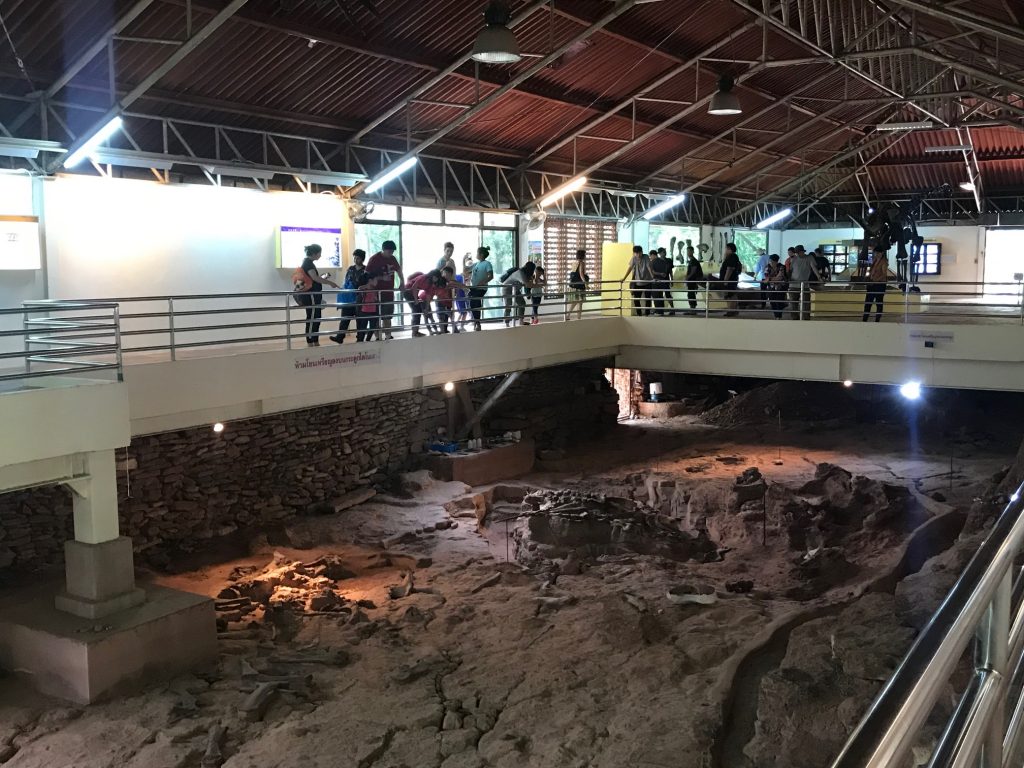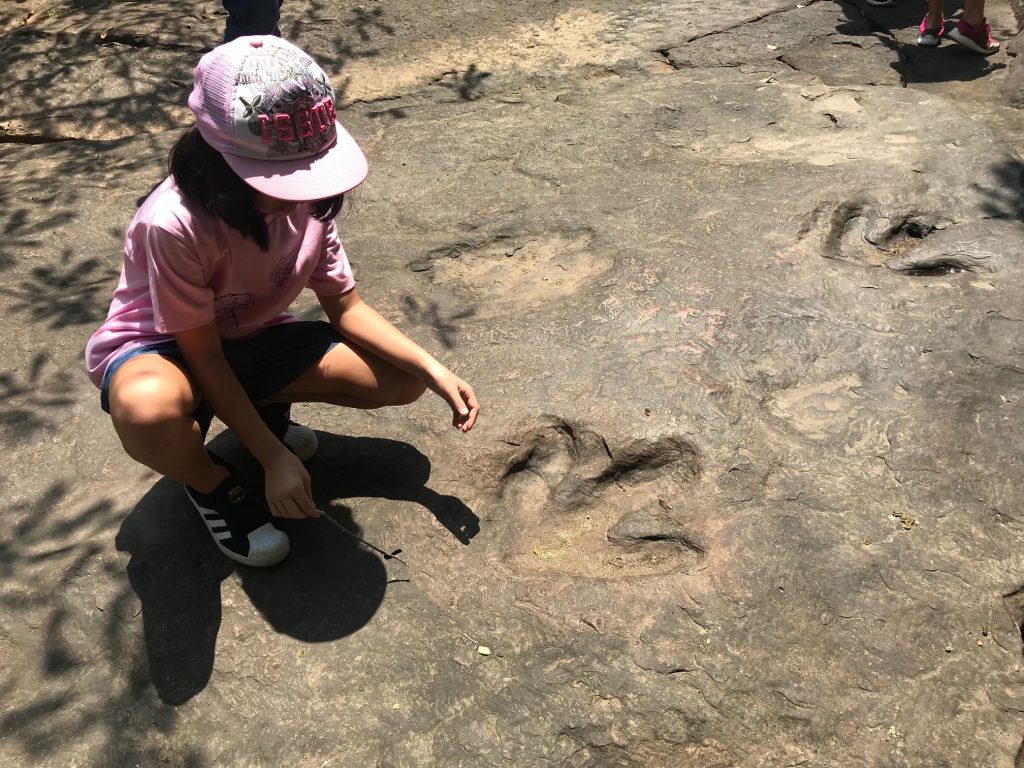Did you know that dinosaurs roamed in Thailand’s northeast region millions of years ago? Once comprised of floodplains with dense forests and vast waterways, the area allowed many species to thrive (that is, until they all disappeared in a mass worldwide extinction). Given the setting in which they lived, dinosaurs remains have been founds in several spots across Isaan, where former waterways served as natural traps for once living things, preserving dinosaur carcasses, fish bones, leaves, shells and more in layers of sediment.
Though these dinosaurs existed around 150 million years ago, major fossils were only formally discovered and studied fairly recently, in the 1970s. In 2008, Thai palaeontologist Dr. Varavudh Suteethorn and a French colleague led a team to excavate Thailand’s most prominent Mesozoic fossil site, Phu Noi, in Kalasin province. They first found 20 dinosaur bone pieces; in subsequent digs, they unearthed more than 1,000 fragments from sauropods, a family of long-necked dinosaurs; the predatory carnosauria; and ancient aquatic animals, including freshwater turtles and sharks.
The fossilised remains of more than 100 species have since been found in Thailand, including nine species of dinosaurs. Here’s where to go to explore the trail of the dinosaurs in Kalasin.
Sirindhorn Museum: Opened in 2008, the Sirindhorn Museum is located about 40 kilometres from the provincial capital of Kalasin (get there via Highway 227, following the signs to Wat Sakawan). Also serving as a research centre, the museum is well organized and maintained, housing a large variety of fossils, educational displays and interactive exhibits over eight zones on several floors.
The first zone presents the origins of the Earth, while the second delves into the origins of life. The subsequent galleries cover the ensuing eras, following the diversification of marine animals and reptiles, the breaking apart of Pangaea, and the emergence of the dinosaurs.
Uncovered in the northeast of Thailand, nine types of dinosaur fossils are displayed in the main gallery, including Phuwiangosaurus Sirindhornae, the first sauropod found in Thailand (named after Her Royal Highness Princess Maha Chakri Sirindhorn) and Isanosaurus Attavipatchi, the oldest sauropod found in Isaan, estimated to be over 200 million years old.
Information in the museum is presented in Thai and English. Admission is 50 baht for locals and 200 baht for foreigners.

Phu Kum Khao Dinosaur Site Museum: Adjacent to the museum, Phu Kum Khao in Wat Sakawan is a hilltop site where numerous fossils and the bones of three species of plant-eating dinosaurs, mostly Phuwiangosaurus Sirindhornae, were discovered in 1994. The excavation site has been preserved, and visitors can look down into the pit and seen a fairly intact dinosaur fossil. Kids would also enjoy walking around the area and seeing the dinosaur models placed in the lush surroundings.


Phu Faek Forest Park: The scenic Phu Faek Forest Park, located in Huai Phueng district, is well worth a visit. From the car park, take a short hike (less than 10 minutes) into the wilderness and you will find multiple footprints preserved in the rock terrace. From 140 million years ago, they were likely made by carnivorous dinosaurs. There isn’t much in the area in terms of conveniences so bring your own food, drinks and snacks. Admission is free.
Kalasin Dinosaur Park: About 5 kilometres from the Sirindhorn Museum, following Highway 227 towards Lam Pao Dam and Dok Ket Beach, the Kalasin Dinosaur Park is a landscaped park with life-sized dinosaur models of Tyrannosaurus Rex and Apatosaurus, among others. There’s not much to do apart from taking photos, but it’s a good rest stop, with toilets and food stalls, that aligns with the overall theme of the trip.
Paleontological Research and Education Centre at Mahasarakham University: Mahasarakham University, one of Thailand’s few palaeontology centres, displays a range of fossils and remains of dinosaurs and animals that researchers have gathered throughout the country. The centre was established in 2002 by the original Thai and French excavation team, including Dr. Varavudh. Contact the centre ahead of time to arrange a visit – if students or staff are available, they may be able to give you a tour of the lab where the painstaking work of extracting the fossils occur. The centre is about a hour’s drive from Khon Kaen.
How to Get to Kalasin
From Bangkok, it’s over a 500-kilometre journey to Kalasin, or a 7+ hour drive. You can also fly on one of the domestic carriers like Nok Air or Thai Smile to a large neighbouring city like Khon Kaen, and rent a car. Having a private car is recommended for ease of getting around once you are there, especially with kids in tow. Another option is to hire a car or a van with a local driver.
In addition to the dinosaur-related sites, Kalasin province is also known for its Phuthai culture, Phraewa silk and Lampao Reservoir.














